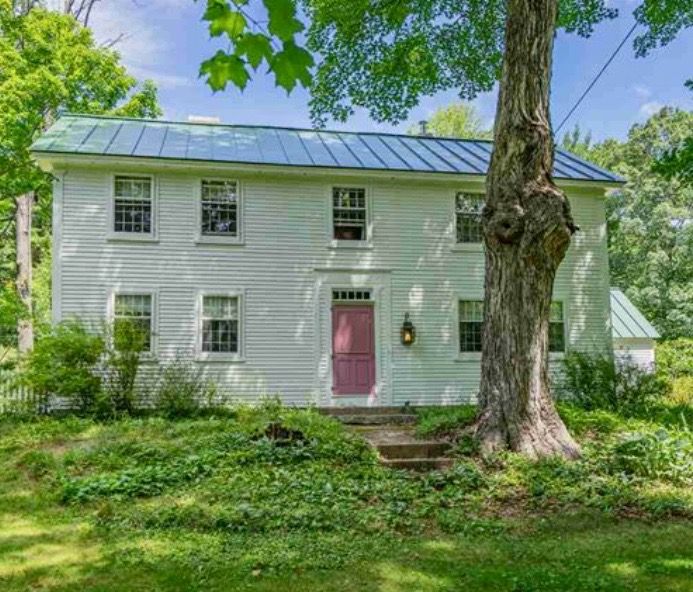New Boston Historical Society
New Boston, New Hampshire

The Simon Dodge farm
Behind the Door: 200 Clark Hill Road
by Mary Atai (September 2019)
His house, now the home of Katie Kachavos at 200 Clark Hill Road, was built about 1790. There was also a large freestanding barn built to the west of the house, which slowly decayed over the years. The original home consisted of a two room over two room early Federal style house with two chimneys and a center hallway on each story.
Although Simon owned fifty acres, he chose to have his home built in the middle of his property and downhill a bit from the geologic crest of Clark Hill, allowing the hillside to protect the house from the bitter northwest winds. The stair balusters, although square, are turned and inserted in a diamond shape. That detail and the double cove molding millwork around some of the doorways mark this house as most likely having been built by a certain unknown itinerant carpenter who built many homes with these hallmarks from Massachusetts up to Hillsborough. The house plan was a common layout and some feel it was built from a "pattern book," but these books of generic plans did not appear until much later in the 1800s.
At some point, in the early 1800s, a cape style house was added. This became the back house, making the original structure the front house. The cape has gunstock corners and wide planked floorboards and was joined to the front house with three hand forged bolts. The front house is entirely pegged (or trunneled), but the backhouse has primitive nails. It is believed the cape house pre-existed the main house and was moved from the south side of Clark Hill about a quarter mile down from the Simon Dodge Farm. The dimensions of the current cellar hole there exactly match the dimensions of the cape house. Houses were easy to move using oxen in those days, since there was no plumbing or electricity.
There have only been four families who have owned this house. The John Wallace family obtained it after the Dodges and lived there until around 1920, renting it out for three years during World War 1 to the O'Neal family. Then Colonel Orne, who was a significant landowner in the area, bought this property for his stepdaughter Lou Fiske as a wedding present when she married Mr. Berry. She raised her family there and passed on in 1967. The house was then bought from the estate of Lou Fiske Berry by Katie and Lou Kachavos in January, 1971. Katie still resides there 48 years later [as of 2019].
When the Kachavoses moved in, the house had been unoccupied for three years. It came complete with a family of woodchucks rummaging around and no actual kitchen. There was a 220 plug for an oven, a hand pump, and a very old sink. Since the large barn was already in great disrepair, they took some of the boards and built all their kitchen cabinets from this beautiful weathered wood. As they worked on the house, they were also able to use many of the notched beams from the barn. This first-generation barn did not completely collapse until 1997. On the east side of the house currently stands a barn structure, known to have been a blacksmith shop.
They have managed the property for timber with great care, with about one cutting completed per decade, always done in a way to open areas for new growth. Katie also raised Christmas trees on the property for about fifteen years. In 1987, they had the path of Clark Hill Road near their house moved so the house would be farther back from passing cars.
The original four rooms stand today much as they were originally built. On a wood planked wall leading to the space above the second floor, the words "Mother Simon Dodge" can still be seen reaching through time, helping to tell the story.
Click here to return to the main page for "Behind the Door" articles.
